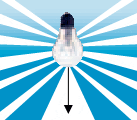
Luminous flux

| Abbreviation: | φ | phi |
| Unit: | lm | lumen |
The luminous flux describes the quantity of light emitted by a light source. The luminous efficiency is the ratio of the luminous flux to the electrical power consumed (lm/W). It is a measure of a lamp’s economic efficiency.
Luminous intensity

| Abbreviation: | I | |
| Unit: | cd | candela |
The luminous intensity describes the quantity of light that is radiated in a particular direction. This is a useful measurement for directive lighting elements such as reflectors. It is represented by the luminous intensity distribution curve (LDC).
Illuminance

| Abbreviation: | E | phi |
| Unit: | lx | lux |
Illuminance describes the quantity of luminous flux falling on a surface. It decreases by the square of the distance (inverse square law). Relevant standards specify the required illuminance (e.g. EN 12464 “Lighting of indoor work-places”).
Illuminance:
E(lx) = luminous flux (lm) / area (m2)
Luminance

| Abbreviation: | L | |
| Unit: | cd/m2 |
The luminance is the only basic lighting parameter that is perceived by the eye. It specifies the brightness of a surface and is essentially dependent on its reflectance (finish and colour).











A really basic and helpful article. Thanks.
explain the technology how the quantity of natural lights controls the quantity of illumination of the building?
you should add UGR AND GLARE